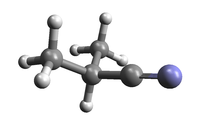|
The first entry from Feb. 2017 was revised.
The experimental data have been taken
from
(1) L. Kolesniková, E. R. Alonso, S. Mata,
J. Cernicharo, and J. L. Alonso,
2017, Astrophys. J. Suppl. Ser. 233 Art. No. 24..
Additional data were taken from
(2) B. E. Arenas, S. Gruet, A. L. Steber,
B. M. Giuliano, and M. Schnell,
2017, Phys. Chem. Chem. Phys., 19 1751.
Initial parameters were taken
from
(3) H. S. P. Müller, A. Coutens, A. Walters,
J.-U. Grabow, and S. Schlemmer,
2011, J. Mol. Spectrosc., 267 100;
in particular, higher order parameters were kept
from that work. Most of the uncertainties in (1)
were deemed to be slightly conservative.
14N hyperfine splitting may be resolvable
for some transitions at MW frequencies, but is
unlikely to be resolved in astronomical observations.
The HFS pattern is expected to be very close to that
of the main species, see e069506.cat.
Predictions should be sufficient for secure
identification in the ISM up to around 300 GHz.
They have been truncated at J = 60.
Predictions with higher J or higher
Ka as well as those with calculated
uncertainties exceeding 0.2 MHz should be
viewed with caution.
The dipole moment components were assumed to agree
with those of the main species, see e069506.cat.
|
